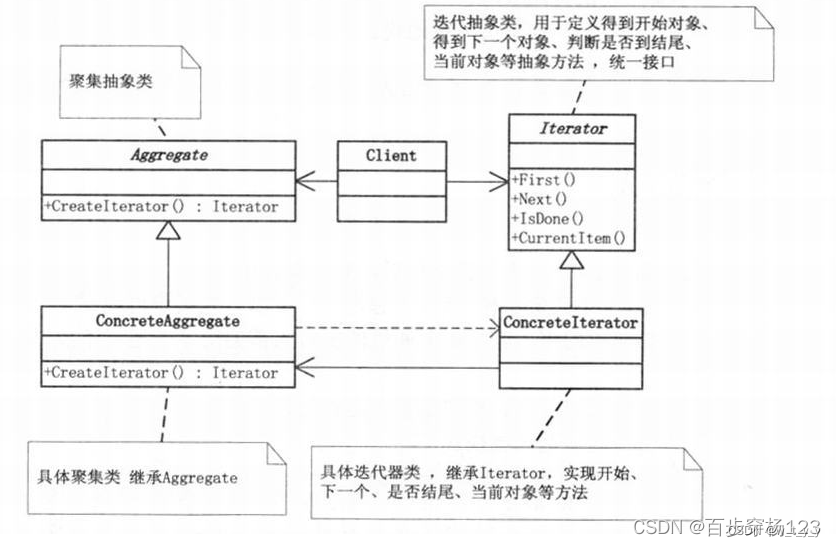一、介绍:
1、定义:迭代器模式 (Iterator Pattern) 是一种行为型设计模式,它提供一种顺序访问聚合对象(如列表、集合等)中的元素,而无需暴露聚合对象的内部表示。迭代器模式将遍历逻辑封装在一个迭代器对象中,使得我们可以使用统一的方式遍历不同类型的聚合对象,同时也可以简化客户端代码。
2、组成:

(1)抽象聚合 (Aggregate) :定义存储、添加、删除聚合元素以及创建迭代器对象的接口。
(2)具体聚合 (ConcreteAggregate) :实现抽象聚合类,返回一个具体迭代器的实例。
(3)抽象迭代器 (Iterator) :定义访问和遍历聚合元素的接口,通常包含 hasNext()、next() 等方法。
(4)具体迭代器 (Concretelterator) :实现抽象迭代器接口中所定义的方法,完成对聚合对象的遍历,记录遍历的当前位置。
二、demo:
1、
package com.demo.ddq.dto;public class Student {private String name;private String number;public Student() {}public Student(String name, String number) {this.name = name;this.number = number;}@Overridepublic String toString() {return "Student{" +"name='" + name + '\'' +", number='" + number + '\'' +'}';}/**省略所有set、get方法*/
}(1)抽象迭代器
//抽象迭代器角色接口
public interface StudentIterator {//判断是否还有元素boolean hasNext();//获取下一个元素Student next();
}
(2)具体迭代器
//具体迭代器角色类
public class StudentIteratorImpl implements StudentIterator{private List<Student> list;//用来记录遍历时的位置private int position = 0;public StudentIteratorImpl(List<Student> list) {this.list = list;}@Overridepublic boolean hasNext() {return position < list.size();}@Overridepublic Student next() {//从集合中或者去指定位置的元素Student currentStudent = list.get(position);position++;return currentStudent;}
}(3)抽象聚合:
//抽象聚合(容器)角色接口
public interface StudentAggregate {//添加学生void addStudent(Student stu);//删除学生void removeStudent(Student stu);//获取迭代器对象StudentIterator getStudentIterator();
}(4)具体聚合:
public class StudentAggregateImpl implements StudentAggregate{private List<Student> list = new ArrayList<>();@Overridepublic void addStudent(Student stu) {list.add(stu);}@Overridepublic void removeStudent(Student stu) {list.remove(stu);}//获取迭代器对象@Overridepublic StudentIterator getStudentIterator() {return new StudentIteratorImpl(list);}
}客户端:
public class Test {public static void main(String[] args) {//创建聚合(容器)对象StudentAggregate aggregate = new StudentAggregateImpl();Student student1 = new Student("张三", "1001");Student student2 = new Student("李四", "1002");Student student3 = new Student("王五", "1003");Student student4 = new Student("钱七", "1004");//添加元素aggregate.addStudent(student1);aggregate.addStudent(student2);aggregate.addStudent(student3);aggregate.addStudent(student4);//删除元素aggregate.removeStudent(student3);//遍历聚合对象// 1.获取迭代器对象StudentIterator iterator = aggregate.getStudentIterator();// 2.遍历while (iterator.hasNext()) {// 3.获取元素Student student = iterator.next();System.out.println(student.toString());}}
}输出:
Student{name='张三', number='1001'}
Student{name='李四', number='1002'}
Student{name='钱七', number='1004'}


)







)





、TimePicker(时间选择))

